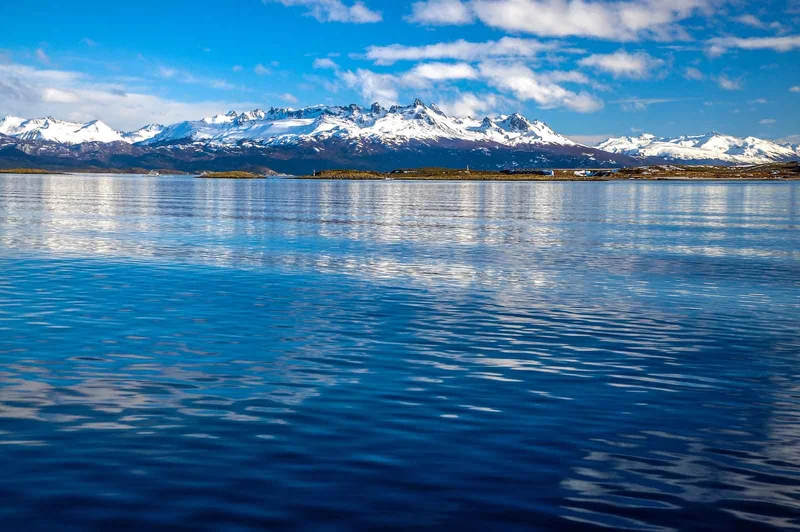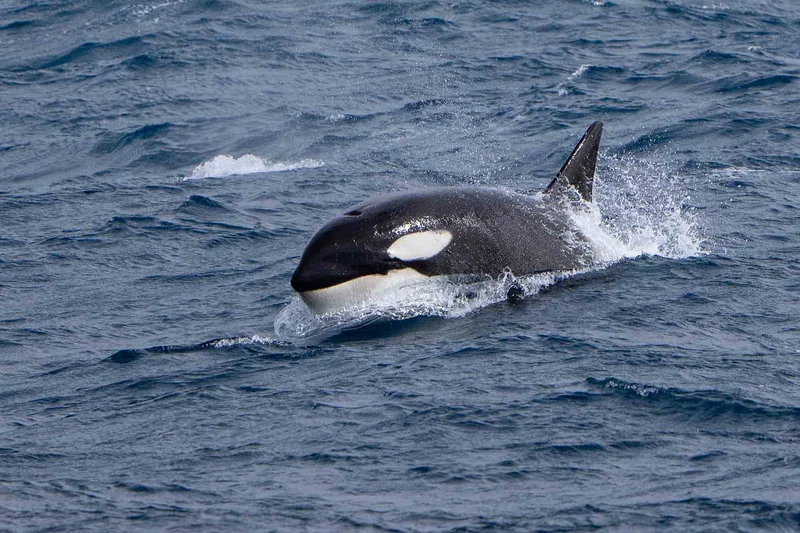
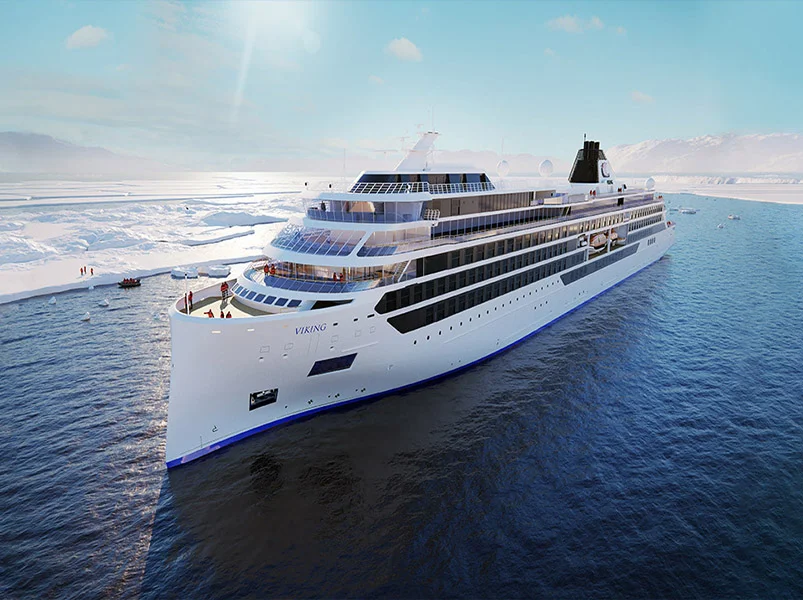
From the Great Lakes to the Antarctic Frontier
Embark on an exhilarating voyage from the heart of the Great Lakes, navigating through the Americas to the breathtaking Antarctic Peninsula. Travel along the iconic St. Lawrence Seaway and the Atlantic coastline, explore the rich history of the Yucatán Peninsula, and cross the legendary Panama Canal. Enhance your adventure with optional excursions to Machu Picchu and the Galápagos, and marvel at the majestic icebergs of the "Last Continent" on this unforgettable expedition.
62 Day Antarctica Itinerary
Day 1: Milwaukee, Wisconsin, United States
Board your ship and get comfortable in your stateroom. Milwaukee was first settled by Europeans in 1818 when French-Canadian fur trader Solomon Juneau arrived. Later, German, Polish, and Eastern European immigrants brought a strong beer-brewing tradition, making Milwaukee the world's top beer producer for much of the 20th century. Today, the city thrives as a hub of art, history, and culture. The RiverWalk, a scenic pedestrian path along the Milwaukee River, is a great place for a relaxing stroll or admiring public art.
Day 2: Milwaukee, Wisconsin, United States
Nestled on Lake Michigan’s shores, Milwaukee sits at the meeting point of three rivers—the Milwaukee, Menomonee, and Kinnickinnic. Long before European arrival, indigenous groups such as the Potawatomi, Menominee, Fox, and Winnebago inhabited the area. Missionary Jacques Marquette explored Milwaukee in 1647, followed by fur traders. The settlement remained a secondary trading post until after the Revolutionary War when Jacques Vieau established the “Milwaukee Outfit,” transforming it into a key trading hub along Lake Michigan’s western shores.
Day 3: Mackinac Island, Michigan, United States
A step back in time, Mackinac Island is a picturesque jewel of the Great Lakes. Nestled in the Straits of Mackinac, where Michigan’s upper and lower peninsulas nearly meet, this charming retreat maintains its Victorian-era charm along streets where only horse-drawn carriages are permitted. The island’s scenic perimeter road is the only state highway in the U.S. that bans motor vehicles. More than 80% of Mackinac is protected as a state park, offering historic sites like the Greek Revival-style Grand Hotel and the 18th-century British-built Fort Mackinac amid untouched natural beauty.
Day 4: Alpena, Michigan, United States
Located in northeastern Michigan’s Lower Peninsula, Alpena sits on the shores of Thunder Bay along Lake Huron. The town is home to Alpena Light, a striking red steel lighthouse built in 1914. Founded in 1840, Alpena originally thrived on fishing and logging and today hosts one of the world’s largest limestone quarries. Architectural landmarks such as the Art Deco-style County Courthouse and the late-Victorian IOOF Centennial Building—once the city’s courthouse—are listed on the National Register of Historic Places.
Day 5: Detroit, Michigan, United States
Detroit, located along one of the four straits connecting the Great Lakes to the St. Lawrence Seaway, has grown into a cultural powerhouse. In 2015, it became the first U.S. city designated a “City of Design” by UNESCO for its innovative urban development. Founded as a French fort in 1701, Detroit later became the heart of the American automobile industry. It is also the birthplace of Motown, a name blending “motor” and “town.” The city’s waterfront showcases striking postmodern and Art Deco skyscrapers, reflecting its rich architectural heritage.
Day 6: Point Pelee, Ontario, Canada
Point Pelee is a pristine peninsula extending into Lake Erie from Ontario, gradually tapering before merging with the water. This unique landscape features woodlands and the largest freshwater marshes in the Great Lakes. Designated a national park in 1918 and protected under the Ramsar Convention for wetlands conservation, it is a haven for wildlife. Positioned along two major bird migration routes, Point Pelee has recorded around 350 bird species. Boardwalks guide visitors through this remarkable ecosystem of open vistas and wave-swept shores.
Day 7: Niagara Falls (Port Colborne), Ontario, Canada
Known as the “Gateway to Navigation,” Port Colborne provides access to one of North America’s greatest natural wonders—Niagara Falls. This breathtaking cascade sends 42 million gallons of water plummeting 20 stories every minute. Spanning both the U.S. and Canada, the falls are divided into three sections: Horseshoe Falls, Bridal Veil Falls, and American Falls. Once a famed honeymoon destination, today it remains an awe-inspiring attraction for visitors worldwide.
Day 8: Toronto, Ontario, Canada
Toronto, one of Canada’s most dynamic cities, is set along the shores of Lake Ontario, facing the scenic Toronto Islands. Founded in 1793 by British Loyalists fleeing the American Revolution, the city is a delight to explore on foot. Visitors can stroll through the historic Rosedale neighborhood, admire the preserved Victorian homes in Wychwood Park, or visit the Distillery District, home to North America’s largest collection of preserved Victorian industrial architecture.
Day 9: Scenic Sailing: St. Lawrence Seaway Locks
An incredible feat of engineering, the St. Lawrence Seaway features a system of locks, canals, and channels that connect the Atlantic Ocean to Lake Superior. Seven locks between Montreal and Lake Ontario help ships bypass rapids and dams. The 27-mile Welland Canal lifts vessels over the Niagara Escarpment to Lake Erie, avoiding Niagara Falls. Known as “Highway H2O,” this waterway is vital for trade and transportation between the U.S. and Canada.
Day 10: Trois-Rivières, Quebec, Canada
Trois-Rivières, the cultural heart of Quebec’s Maurice region, was founded in 1634, making it the second permanent settlement in New France after Quebec City. It played a crucial role in fur trading with Indigenous nations. Its English name, “Three Rivers,” reflects its location where two islands split the Saint-Maurice River into three channels before it joins the St. Lawrence River. Today, the city’s Old Town is adorned with elegant century-old buildings that add to its historic charm.
Day 11: Quebec City, Quebec, Canada
Quebec City is often considered the most French-influenced city in North America. The iconic Château Frontenac, perched atop the Old Town, resembles the grand castles of France’s Loire Valley. The city’s winding, cobblestone streets are lined with white-stone buildings, reminiscent of medieval European villages. The only walled city in North America outside of Mexico, Quebec City was fortified in the 17th century to secure its strategic location atop Cape Diamond, offering a commanding view of the St. Lawrence River.
Day 12: Scenic Sailing: St. Lawrence River
Flowing through lush landscapes, the St. Lawrence River links the Great Lakes to the Atlantic Ocean, offering some of North America’s most scenic vistas. The river passes through cultural centers like Quebec City, Montreal, and the picturesque Île d’Orléans. Eastward, it expands into the world’s largest estuary, featuring charming villages, rolling hills, and rugged coastlines. At its mouth, Île d’Anticosti marks the transition from river to open sea.
Day 13: Cap-aux-Meules, Quebec, Canada
Cap-aux-Meules, or "Grindstone Cape," is a village on one of Quebec’s 13 Magdalen Islands. Although its English name is rarely used, the French moniker remains official. This low-lying island, encircled by dramatic cliffs, was historically home to the Mi’kmaq people, who visited seasonally for walrus hunting. European exploration began with Jacques Cartier in 1534. Some modern residents trace their lineage to shipwreck survivors, living in homes built using wood salvaged from the sea.
Day 14: Cape Breton Island (Louisbourg), Nova Scotia, Canada
Cape Breton Island sits at the meeting point of the Gulf of St. Lawrence and the Atlantic Ocean. Its diverse terrain includes rolling farmland, highlands, and thick forests, making it a paradise for hikers and kayakers. The island is also a sanctuary for bird species like cormorants, hawks, and skuas. Once a French stronghold, the fortified town of Louisbourg played a pivotal role in North American colonial conflicts. Today, its partially reconstructed fortress stands as a National Historic Site.
Day 15: Lunenburg, Nova Scotia, Canada
Nova Scotia’s coastline remains a pristine natural wonder, with rolling hills, dense forests, and steep cliffs that plunge into rugged shores. Lunenburg, a former shipbuilding hub, was the first permanent European settlement in North America north of Florida. Its Old Town, a UNESCO World Heritage Site, is the best-preserved example of planned British colonial development in the region, showcasing colorful 18th- and 19th-century buildings that reflect its rich maritime history.
Day 16-17: Sailing the Atlantic Ocean
Cross the vast Atlantic Ocean, which is divided north to south by the Mid-Atlantic Ridge—the world’s longest underwater mountain range, stretching farther than the Rockies, Himalayas, and Andes combined. As you sail, take advantage of your ship’s amenities. Enjoy a brisk walk on the Promenade for a breath of fresh ocean air or start your day with an energizing workout in the state-of-the-art Fitness Center.
Day 18: Norfolk, Virginia, United States
Set along a wide natural harbor, Norfolk is home to the world’s largest naval base. Along its seven miles of waterfront wharves, numerous naval vessels stand as a testament to the city’s deep military heritage. Norfolk’s identity is closely tied to the U.S. Navy and other branches of the military. It is also the final resting place of General Douglas MacArthur, the renowned U.S. Army commander, and his wife, at the MacArthur Memorial. Housed in Norfolk’s former City Hall, this museum offers an insightful look into his life, featuring preserved uniforms, personal papers, and memorabilia.
Day 19: Sailing the Atlantic Ocean
Traverse the legendary waters once believed by medieval Europeans to be inhabited by dragons beyond the horizon. Enjoy the ship’s amenities as you sail. Perhaps take a refreshing walk on the Promenade or begin your morning with a session in the well-equipped Fitness Center.
Day 20: Charleston, South Carolina, United States
Charleston is a historic gem of Southern culture. Established in 1670, it is set between two estuaries and overlooks a deep natural harbor. A crucial commercial port since colonial times, Charleston played a key role in the secessionist movement, with the Confederate capture of Fort Sumter on April 14, 1862, marking the start of the Civil War. Today, the city is known for its beautifully preserved colonial homes, historic churches, charming streets, and expansive gardens. The Charleston Museum, founded in 1773, holds the distinction of being the oldest museum in the United States.
Day 21: Sailing the Atlantic Ocean
The Atlantic Ocean is home to over half of the world’s fisheries, supplying millions of tons of fish and marine species annually for food and industry. Relax at the Finse Terrace, an open-air lounge named after a famous Norwegian mountain plateau. Unwind in comfort on heated couches beside lava rock “firepits,” designed to provide a cozy outdoor experience in any weather, as you take in the vast ocean views.
Day 22: Fort Lauderdale, Florida, United States
A favorite retreat for both locals and visitors, Fort Lauderdale radiates the laid-back charm of South Florida’s coastline. Miami’s vibrant Cuban culture enlivens its historic Old Havana district, while sleek high-rises tower over Biscayne Bay. On the barrier islands, South Beach dazzles with its blend of seaside glamour and pastel-hued Art Deco architecture. Further north, the seven-mile-long Fort Lauderdale Beach offers a more relaxed atmosphere, while Las Olas Boulevard tempts visitors with inviting cafés and stylish boutiques.
Day 23: Sailing the Gulf of Mexico
The Gulf of Mexico has played a significant role in the history of North and Central America. In 1497, explorer Amerigo Vespucci is believed to have been the first European to enter the gulf’s waters, mapping its coast and reshaping world geography. As you sail, connect with fellow travelers and enjoy the soothing sounds of classical music in the Living Room, an elegant space for relaxation. Sip on a cup of coffee or indulge in a refreshing cocktail as you unwind in this inviting setting.
Day 24: Cozumel, Mexico
Cozumel is a gateway to Mexico’s ancient past. At San Gervasio, pre-Columbian women once made offerings to Ix Chel, the Mayan goddess of the moon and fertility. Spanish influences endure in the vibrant colonial architecture and traditions of San Miguel, as well as the scenic lighthouse at Punta Sur. Today, Cozumel, located off the Yucatán Peninsula, draws history enthusiasts and snorkelers alike. The Cozumel Reefs National Marine Park, part of the world’s second-largest coral reef system, offers an underwater paradise teeming with marine life.
Day 25-26: Sailing the Caribbean Sea
Sail through the turquoise waters of the Caribbean, where legends of swashbuckling pirates and hidden treasures were born. While at sea, indulge in world-class dining aboard your ship. Explore a variety of international flavors at the World Café, enjoy al fresco dining on the Aquavit Terrace, or savor regional specialties in The Restaurant.
Day 27: Scenic Sailing: Panama Canal
A marvel of 20th-century engineering, the Panama Canal links the Pacific and Atlantic Oceans, cutting across the narrow Isthmus of Panama. The full 48-mile transit takes approximately eight to ten hours, passing through Gatun Lake and the Culebra Cut, an artificial valley carved through the Continental Divide. This impressive waterway uses a series of locks to raise and lower ships 85 feet, aided by electric locomotives called mulas. A journey through the canal is a once-in-a-lifetime experience, offering an up-close look at human ingenuity.
Day 28: Panama City (Fuerte Amador), Panama
A dazzling metropolis overlooking the Pacific, Panama City seamlessly blends modern sophistication with colonial history. As Central America’s most cosmopolitan city, it is both a hub for international finance and a treasure trove of historic sites. The atmospheric Casco Viejo, the city’s Old Town, sits on a peninsula and is home to some of Panama’s most cherished landmarks, including centuries-old churches, palaces, and lively plazas. Nearby, the famed Panama Canal remains one of the world’s greatest engineering achievements, guiding vessels along its 48-mile course to the Caribbean Sea.
Day 29: Sailing the Pacific Ocean
Cross the Mar Pacífico, or "peaceful sea," as named by Ferdinand Magellan nearly 500 years ago. While at sea, rejuvenate your body and mind in the Scandinavian-inspired Spa, a sanctuary of relaxation and wellness. Whether you unwind in the Sauna, refresh in the Snow Grotto, or take a soothing dip in the Thermal Pool, you’ll emerge feeling renewed and revitalized.
Day 30: Manta, Ecuador
Manta has long been shaped by the rhythm of the sea. As Ecuador’s largest seaport, the city bustles with a lively fish market where freshly caught sea bass, tuna, and other delicacies are displayed. The Manabita cuisine, highly regarded throughout Ecuador, is a celebrated gastronomic tradition. Once a pre-Columbian trading hub known as Jocay, Manta also honors its cultural heritage with artisan exhibits. Just a short distance away, Montecristi thrives as a center of craftsmanship, famous for its intricate wickerwork and the original handwoven Panama hats.
Day 31-32: Sailing the Pacific Ocean
Journey across the world’s largest ocean, spanning nearly 64 million square miles. Twice the size of the Atlantic, the Pacific is a realm of vast extremes. As you sail, unwind in the Explorers’ Lounge, an inviting space inspired by legendary voyages of discovery. Take in breathtaking views through two-story panoramic windows while enjoying a cocktail with fellow travelers, or settle into a cozy nook with a good book.
Day 33: Lima (Callao), Peru
Founded in 1535 by Francisco Pizarro as La Ciudad de los Reyes (“City of Kings”), Lima quickly flourished as the capital of Spain’s Viceroyalty of Peru. Home to the oldest university in the Americas, the National University of San Marcos, the city is one of South America’s most cosmopolitan centers. Its architecture is a striking blend of styles, from early colonial and Spanish Baroque to Neoclassical and Art Nouveau. The historic center, adorned with hundreds of balconies from the viceroyalty era, is a designated UNESCO World Heritage Site.
Day 34-35: Sailing the Pacific Ocean
Sail across the Pacific, an immense body of water that covers over 30% of the Earth’s surface and touches the continents of Asia, Australia, and the Americas. Take in the endless horizon and enjoy an open-air dining experience on the Aquavit Terrace, where you can savor a selection of international dishes, casual favorites, and expertly crafted cocktails inspired by global destinations.
Day 36: Iquique, Chile
Nestled between the Pacific Ocean and the Pampa del Tamarugal, a vast plateau in the Atacama Desert, Iquique is a vibrant coastal city with a rich history. Once part of Peru, it thrived during the saltpeter boom before becoming Chilean territory in 1883 after the War of the Pacific. The city’s architectural gems line the central Arturo Prat Square, from the grand Municipal Theater and the ornate Casino Español to the Gothic-Moorish Clock Tower. Well-preserved Georgian-style mansions, remnants of Iquique’s 19th-century mining prosperity, add to the city’s charm.
Day 37-38: Sailing the Pacific Ocean
Cross the vast Pacific and explore its remarkable geology, home to more than 75,000 underwater volcanoes, many of which remain active. While at sea, make the most of your ship’s amenities. Take a refreshing stroll along the Promenade for crisp ocean air or start your day with an energizing session in the state-of-the-art Fitness Center.
Day 39: Santiago (Valparaíso), Chile
Santiago, Chile’s dynamic capital, is one of the largest cities in the Americas, featuring an architectural landscape that spans centuries, from Neoclassical and Neo-Gothic to Art Deco and contemporary styles. The city’s main port, Valparaíso, is often likened to San Francisco due to its many cerros (hills). Once a thriving maritime hub, its importance declined after the Panama Canal opened. Today, its 19th-century Victorian-style architecture, steeply terraced neighborhoods, and historic ascensores (funiculars) offer a glimpse into its golden era. From the hilltops, the panoramic views are breathtaking.
Day 40: Sailing the Pacific Ocean
Though officially named in 1521, civilizations have navigated the Pacific Ocean since at least 3000 BC. As you sail, indulge in the ship’s world-class dining options. Visit Mamsen’s, a casual gourmet deli, anytime from early morning to late at night for a taste of traditional Norwegian fare. Or, enjoy a refined Italian dining experience at Manfredi’s, where you can savor Tuscan-inspired dishes, Milanese risotto, and other authentic Italian specialties.
Day 41: Scenic Sailing: Chilean Fjords
A breathtaking expanse of towering peaks, lush islands teeming with wildlife, and a stunning mix of glaciers and rivers flowing into shimmering waters, Chile’s fjords are among the most remote and untamed landscapes on Earth. As the crystal-clear waters wind through vast ice fields, dramatic mountain ranges, and charming fishing villages, they create an awe-inspiring setting of rugged natural beauty.
Day 42: Puerto Chacabuco, Chile
A small Patagonian outpost, Puerto Chacabuco serves as a gateway to the region’s untouched wilderness. The port’s name commemorates the 1817 Battle of Chacabuco, a pivotal victory in Chile’s War of Independence led by national hero José de San Martín and the Army of the Andes. This striking landscape is defined by jagged peaks, deep ravines, brilliant blue glaciers cascading into the sea, and dense forests clinging to steep slopes—one of the world’s most breathtaking and inspiring destinations.
Day 43: Scenic Sailing: Chilean Fjords
Chile’s fjords and channels were originally home to indigenous groups who crafted their canoes and dwellings from Pilgerodendron uviferum, a local conifer. In the mid-16th century, Spanish explorers navigated these intricate waterways to escape the treacherous Pacific swells and unpredictable weather. Due to the harsh climate and a dwindling population, colonial expansion was minimal, leaving the region sparsely inhabited—a reality that persists today.
Day 44-45: Exploring Chilean Glaciers
The vast Patagonian Ice Sheet once blanketed southern Chile during the last Ice Age. Around 12,000 years ago, warming temperatures triggered its retreat, carving out the dramatic Patagonian landscape we see today. Two massive remnants of this ancient ice sheet—the Northern and Southern Patagonian Ice Fields—stretch across more than 5,400 square miles, making them the third-largest frozen landmass on the planet. At their edges, colossal blue-tinged glaciers calve into the fjords, sending massive icebergs drifting through the frigid waters.
Day 46: Scenic Sailing: Chilean Fjords
Stretching nearly 1,000 miles from Cape Horn to the Reloncaví Estuary near Puerto Montt, the Chilean fjords were shaped over millions of years by retreating glaciers. These spectacular waterways weave through a network of channels and passages framed by towering ice walls, dense forests, and rugged mountain ranges. The coastline teems with wildlife, from colonies of Magellanic penguins and basking elephant seals to playful dolphins and migrating humpback whales. Occasionally, orcas can be spotted hunting in these nutrient-rich waters.
Day 47: Punta Arenas, Chile
Founded in 1848 as a penal colony, Punta Arenas is perched on the eastern shores of the Brunswick Peninsula, surrounded by dramatic mountain scenery. The city was once a crucial stop for mariners navigating the continent by sea. The discovery of gold and the expansion of vast sheep farms in the surrounding region soon attracted European settlers. Over time, Punta Arenas evolved into one of Chile’s most important ports, serving as a key stopover for transcontinental shipping before the opening of the Panama Canal.
Day 48: Exploring Chilean Glaciers
Spanning the Chile-Argentina border, the Southern Patagonian Ice Field extends along the spine of the Andes for more than 200 miles. Chile is home to nearly 80% of South America’s glaciers, covering approximately 7,700 square miles. These vast ice fields serve as essential freshwater reserves, sustaining Patagonia’s unique ecosystems and diverse wildlife.
Day 49: Garibaldi Fjord, Chile
Tucked within Alberto de Agostini National Park, where the Andes meet the sea, the Garibaldi Fjord is an untouched natural wonder. Recognized as a UNESCO Biosphere Reserve, this remote fjord is home to an array of wildlife. Its steep valley walls are adorned with glacial ice, while floating icebergs drift alongside seals and sea lions. The fjord is fed by the mighty Garibaldi Glacier, a 12-square-mile expanse of ice that towers above passing ships, creating a dramatic and humbling spectacle.
Day 50: Scenic Sailing: Cape Horn
Marking the convergence of the Atlantic and Pacific Oceans, Cape Horn is named after the Dutch city of Hoorn in the Netherlands. This rugged, treeless island is part of the remote Hermite Islands archipelago and is often considered the southernmost point of the South American continent. Rising from Hornos Island is a dramatic Jurassic-age volcanic massif, atop which stands the historic Cape Horn Lighthouse. Since 1991, this beacon has provided guidance and reassurance to sailors navigating these notoriously challenging waters.
Day 51: Ushuaia, Argentina
The southernmost city in the world, Ushuaia is dramatically positioned between the Beagle Channel and the rugged slopes of the Andes. Its remote and frontier-like atmosphere is heightened by the presence of Antarctic explorers preparing for expeditions that launch from its shores. Ushuaia serves as the gateway to the legendary Tierra del Fuego ("Land of Fire"), so named by early Spanish explorers who saw the constant fires of the indigenous Yámana people burning along the shore. This largely untouched region consists of the vast island of Tierra del Fuego and countless smaller Chilean and Argentine islets.
Day 52: Sailing the Drake Passage
Named after the famed 16th-century English explorer Sir Francis Drake, the Drake Passage is a formidable stretch of ocean spanning 600 miles between Cape Horn and Livingston Island in the South Shetland archipelago. As you sail, indulge in the Scandinavian-inspired Spa, a Nordic haven of holistic wellness. Whether you relax in the Sauna, refresh in the Snow Grotto, or soak in the Thermal Pool, this rejuvenating retreat will leave you feeling revitalized as you journey onward.
Day 53-59: Exploring Antarctica
Antarctica is a land of unearthly beauty, where the stark contrast between ice and sea has captivated explorers for centuries. This pristine wilderness is a landscape of towering glaciers, shimmering icebergs, and basalt cliffs blanketed in snow. In the serene stillness, fur seals lounge on drifting ice sheets, while in the distance, the dramatic calving of a glacier sends thundering echoes across the frozen expanse. These nutrient-rich waters support an array of marine life, including humpback, fin, and massive blue whales, which sometimes surface to greet passing expedition ships.
Day 60: Sailing the Drake Passage
The Drake Passage is infamous for its fierce winds, towering waves, and icy currents, making it one of the most treacherous maritime crossings in the world. As you navigate these legendary waters, immerse yourself in an enriching experience at The Aula, one of the most advanced learning venues at sea. Attend an insightful lecture or enjoy a film on the 8K laser-projected panoramic screen. With its retractable floor-to-ceiling windows revealing breathtaking 270° views, this indoor-outdoor space offers an unrivaled connection to nature.
Day 61: Scenic Sailing: Cape Horn
Known in Spanish as Cabo de Hornos, Cape Horn is a towering rocky headland on Hornos Island in the Tierra del Fuego archipelago. It marks the northern boundary of the Drake Passage and is the meeting point of the Atlantic and Pacific Oceans. First rounded in 1616 by Dutch navigator Willem Schouten and Belgian explorer Jacob Le Maire, Cape Horn is infamous for its perilous waters, where fierce winds, massive waves, and strong currents make navigation a formidable challenge. Icebergs add an additional layer of danger to this already legendary maritime route.
Day 62: Ushuaia, Argentina
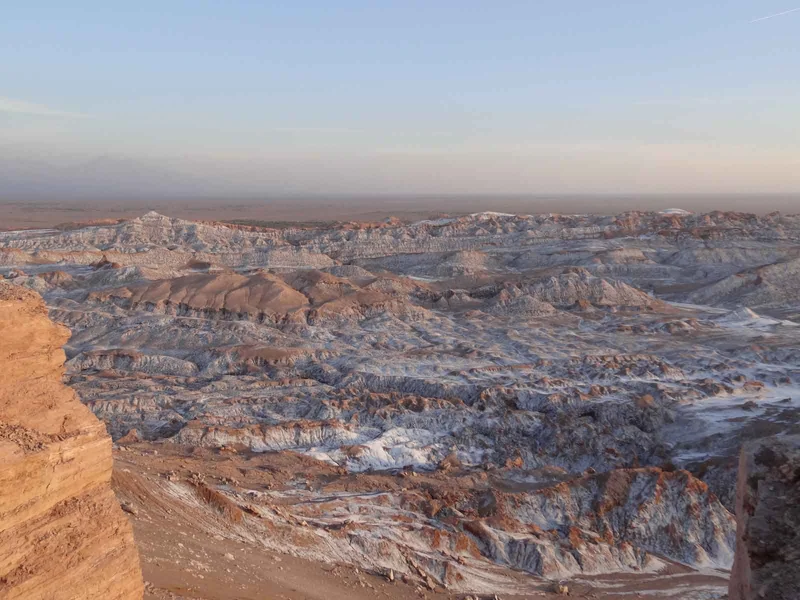
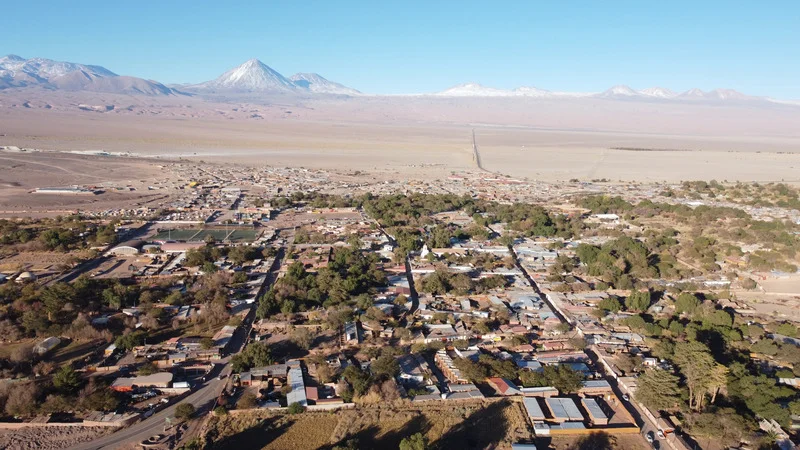
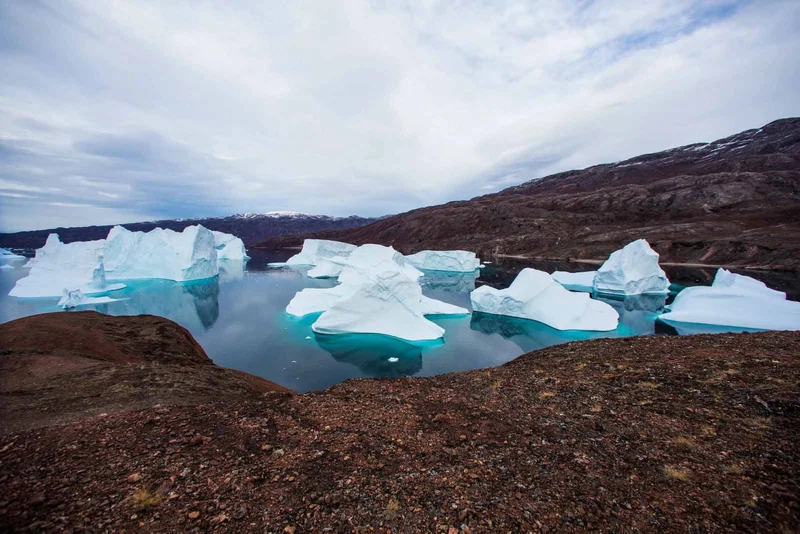
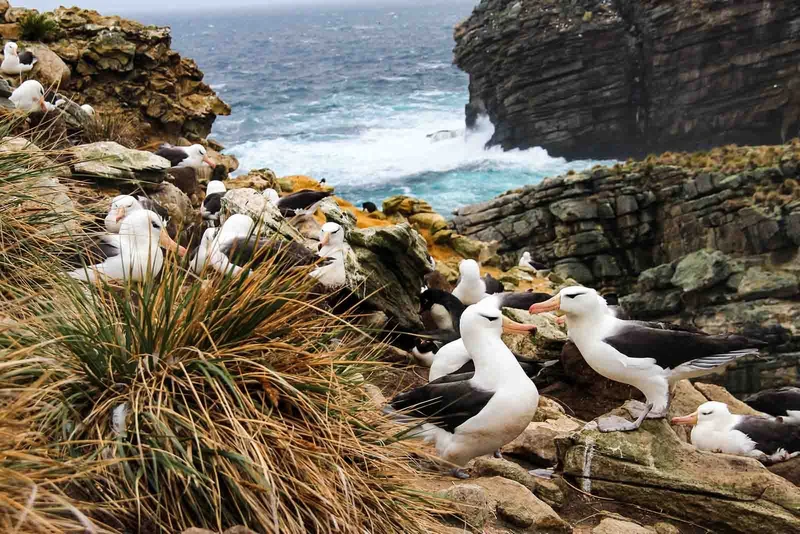
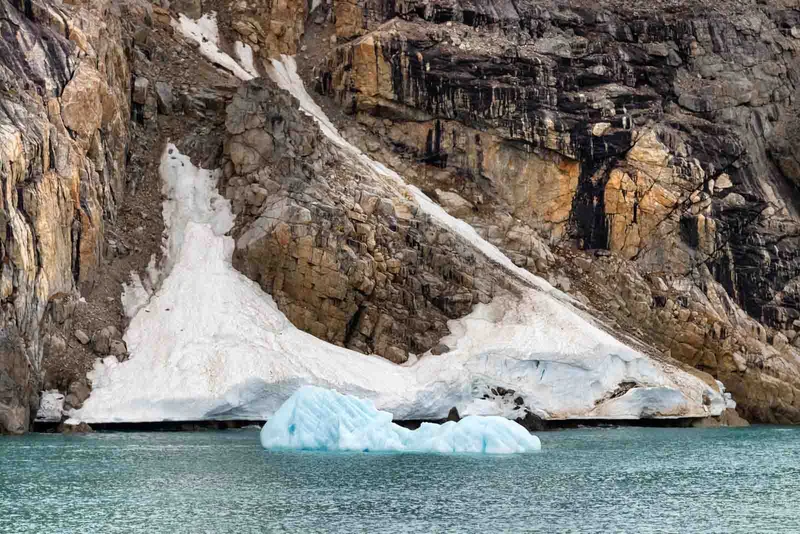
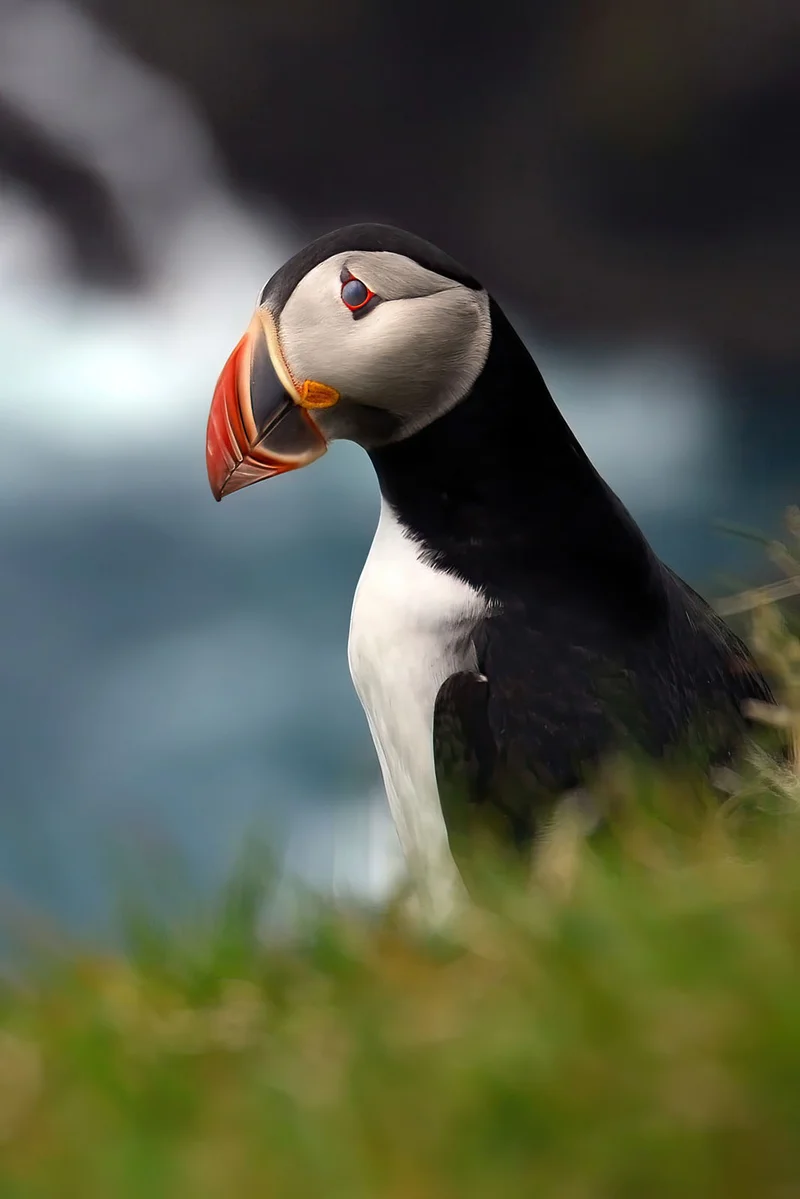
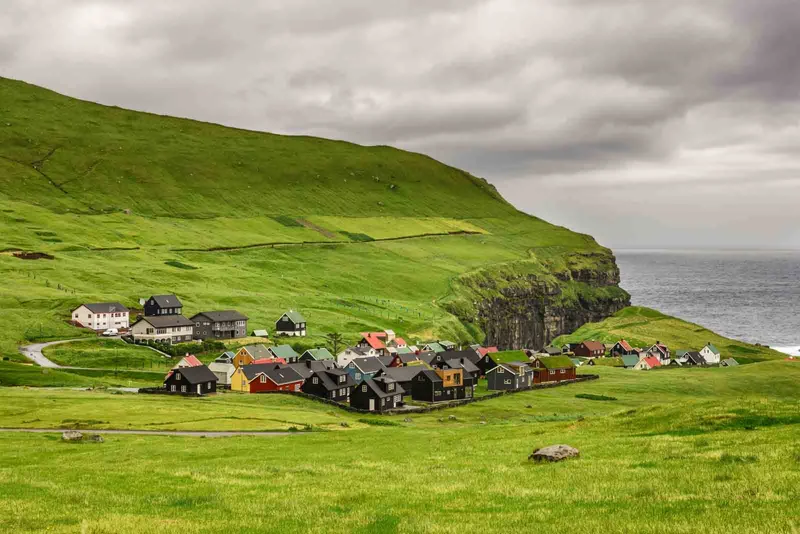
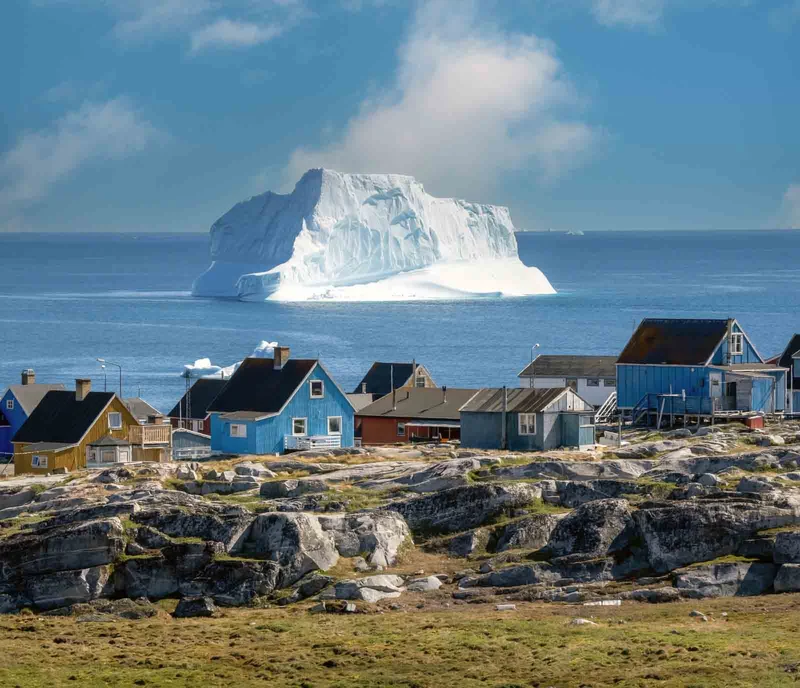
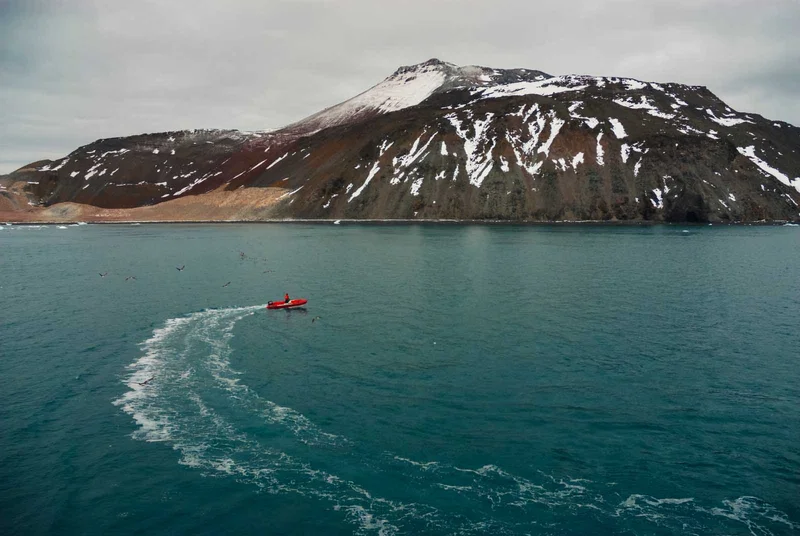
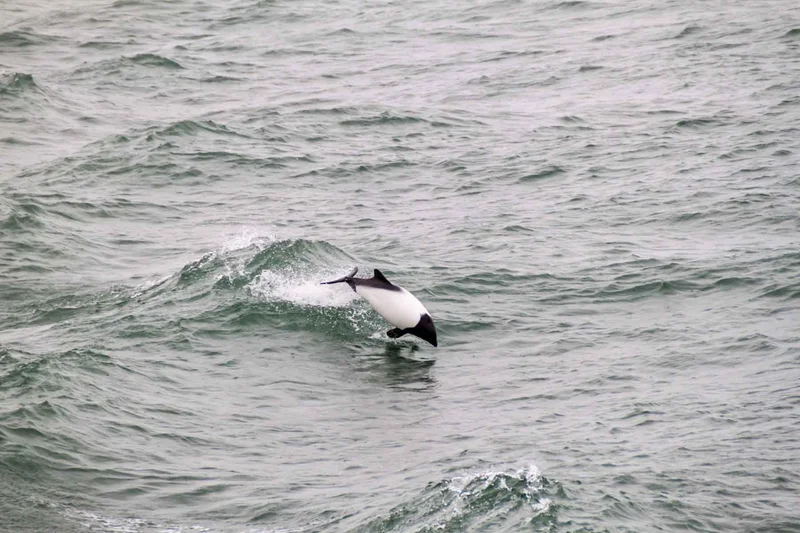

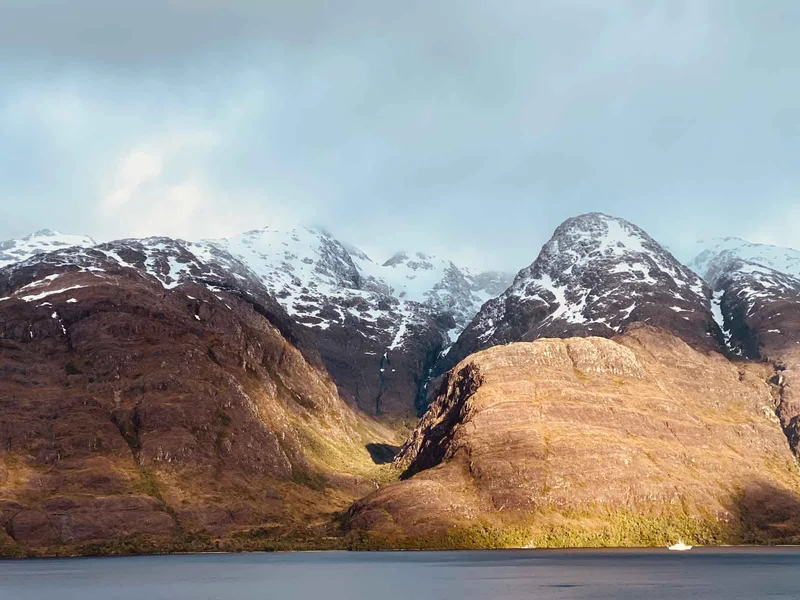
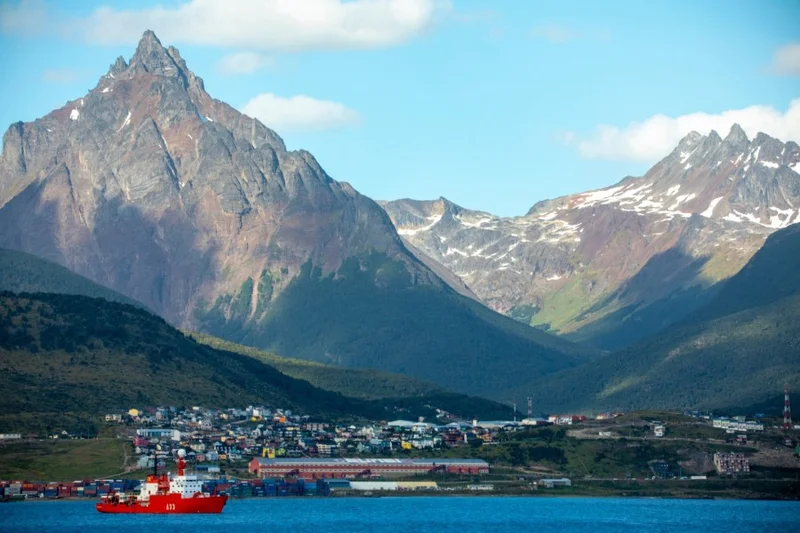
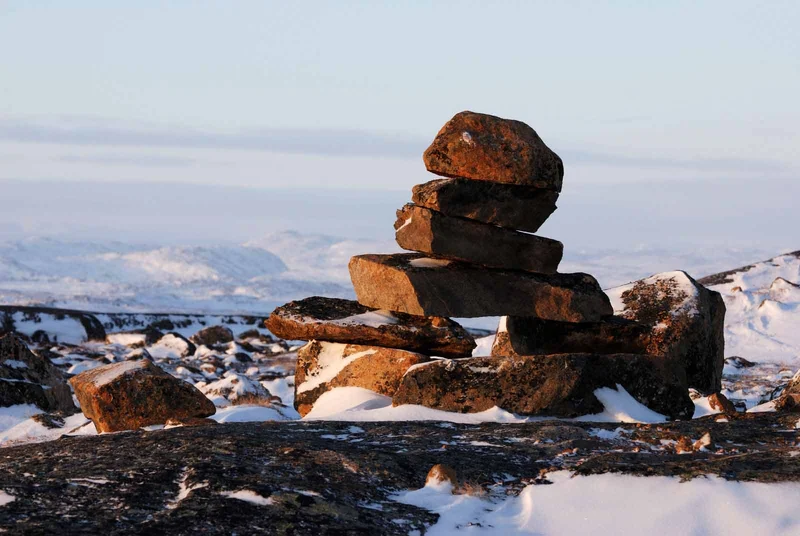
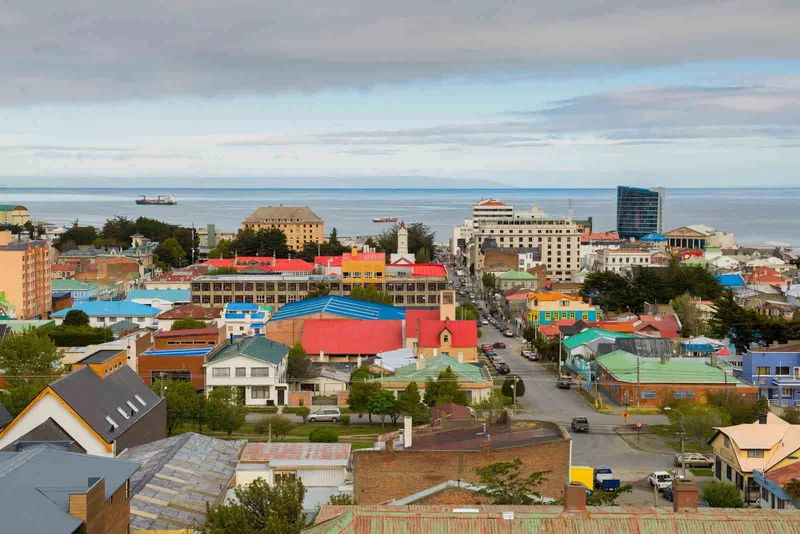
62 Day Antarctica Itinerary Highlights
- Sail from the Great Lakes to Antarctica on a grand expedition
- Explore the St. Lawrence Seaway and the Atlantic coastline
- Discover the Yucatán Peninsula and transit the Panama Canal
- Optional overland tours to Machu Picchu and the Galápagos
- Marvel at the icebergs and wildlife of the Antarctic Peninsula
Itinerary Map
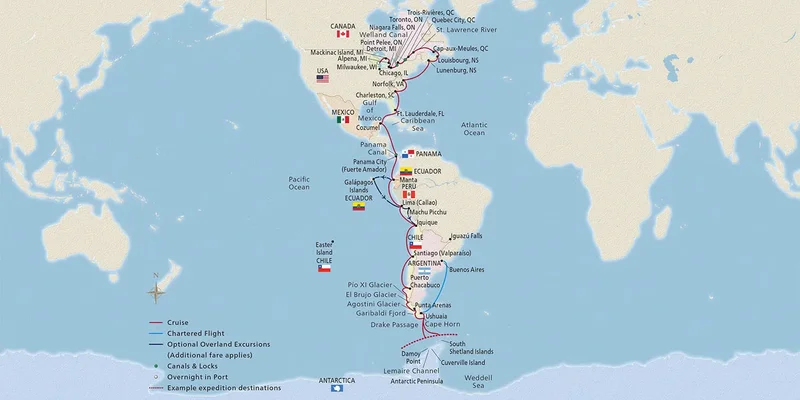
62 Day Antarctica cruise activities
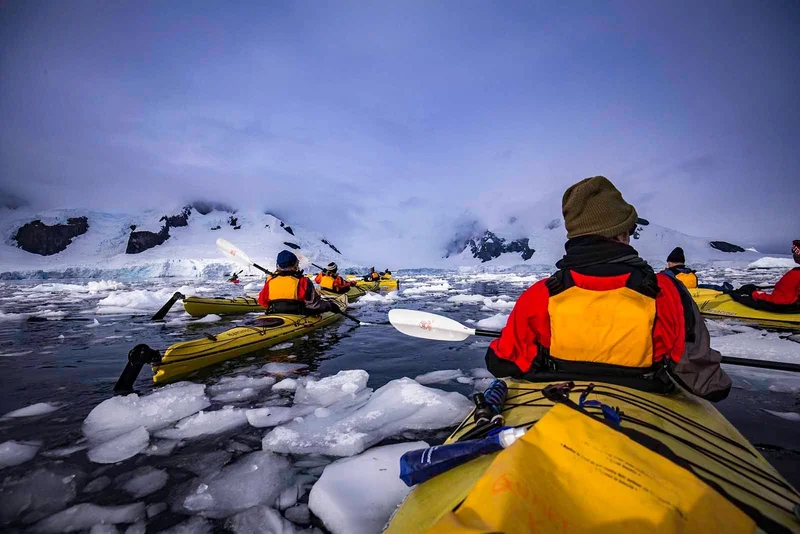
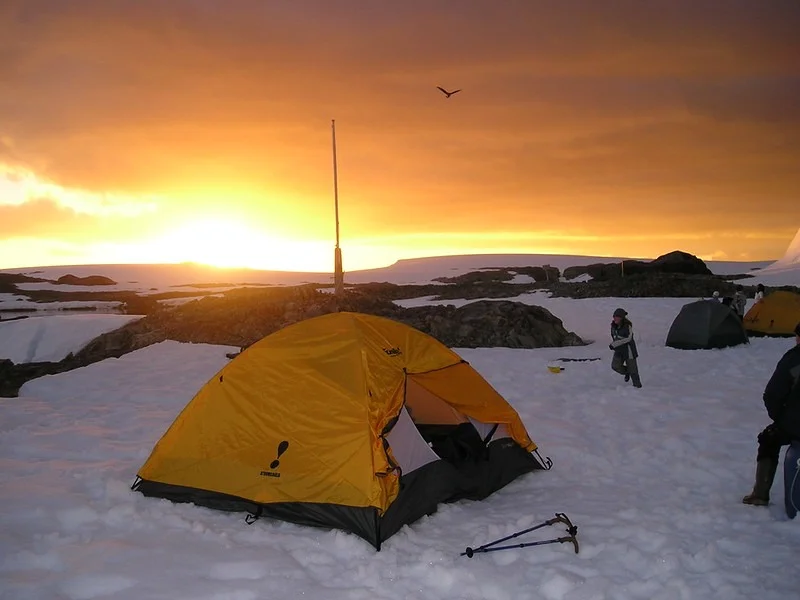
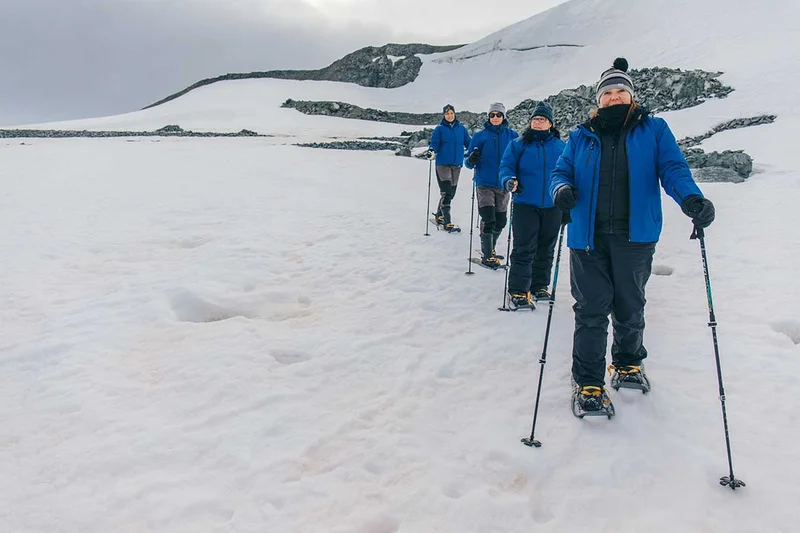
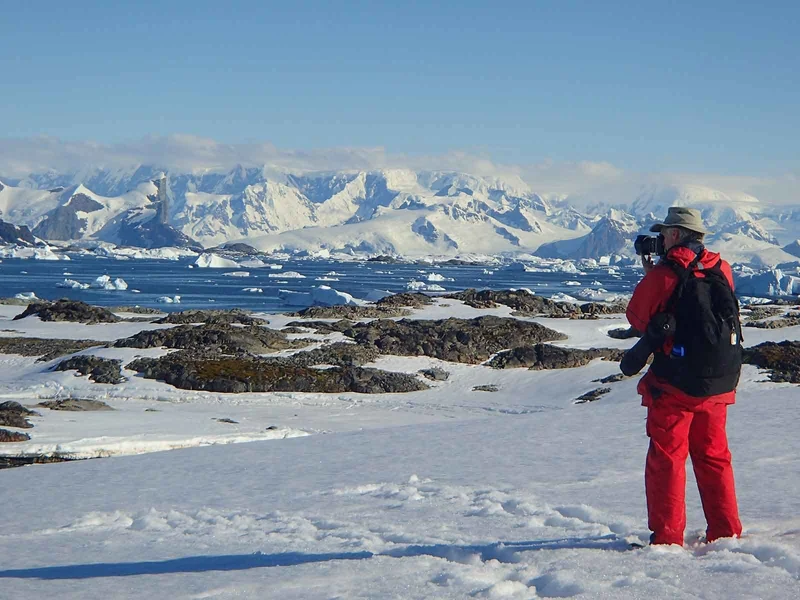
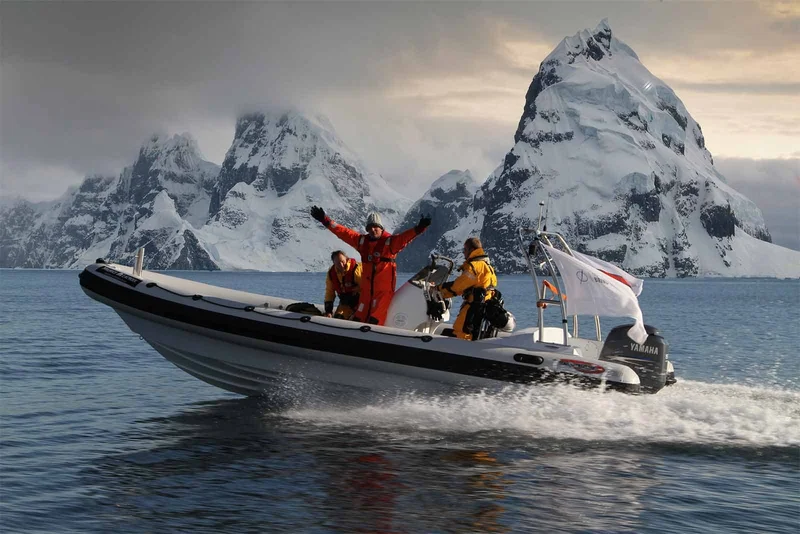

Animals you might see on this itinerary
Why travel with us?
Would you like to know why booking with us is the best choice?
Discover the BenefitsSimilar Itineraries
